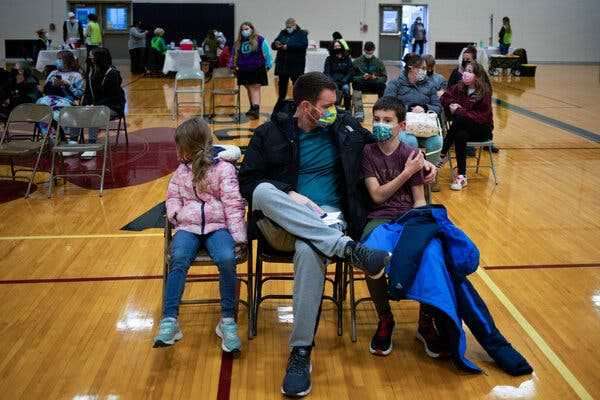Thus far, Moderna’s shots have been authorized only for adults.
-
Send any friend a story
As a subscriber, you have “>10 gift articles to give each month. Anyone can read what you share.
Give this article
- Read in app
This article is part of our Daily Covid Briefing

Families wait in at a COVID-19 clinic in Berkley, Michigan, in January.
The Food and Drug Administration’s committee of independent vaccine experts will meet Tuesday to consider Moderna’s coronavirus vaccine for children ages 6 to 17. Thus far, Moderna’s shots have been authorized only for adults.
Committee members will evaluate and vote on whether to recommend the company’s two-dose vaccine for 6- to 11-year-olds at half the strength of the adult version, and for 12- to 17-year-olds at the same strength as adults.
The F.D.A. will then decide whether to authorize the children’s doses for emergency use — following what has been a considerable wait. Moderna asked federal regulators to clear its vaccine for adolescents and older teens last June, a month after Pfizer won emergency authorization for its coronavirus vaccine to be used in 12- to 15- year-olds.
Federal scientists, concerned about possible links between the Moderna vaccine and a rare heart condition, myocarditis, chose to delay a decision until further studies were conducted. Young men were considered to be at higher risk of the side effect after both the Moderna and Pfizer vaccines, although some studies indicated higher rates of myocarditis in Moderna recipients.
Moderna then delayed its application for 6- to 11-year-olds. The company says concerns about myocarditis have now subsided after further research and real-world evidence.
To evaluate the vaccine, Moderna studied immune responses generated in children 6 to 17 and compared them to the level of neutralizing antibodies in people 18 to 25 after vaccination. The vaccine met the trial criteria. That, and the F.D.A.’s conclusion that side effects in the age group are minimal, suggests that the advisory panel may recommend it and federal regulators may authorize it.
The meeting is set to run from 8:30 a.m. to 5 p.m. Eastern, concluding with a series of votes, and can be viewed on YouTube. A separate committee that advises the Centers for Disease Control and Prevention is expected to take up the matter this weekend, after which Dr. Rochelle P. Walensky, the agency’s director, will issue her own recommendation. Children could begin receiving the shots soon after Dr. Walensky’s approval.
In a second all-day meeting on Wednesday, the F.D.A. panel will consider Moderna’s vaccine for children under 6 and Pfizer-BioNTech’s vaccine for children under 5. About 18 million children under 5 are the only Americans who are not yet cleared for coronavirus shots.
Whether there will be any real demand for Moderna’s vaccine among teens and older children, given that the Pfizer-BioNTech vaccine has already been available to them for months, is a question likely to surface at Tuesday’s meeting. Uptake of the Pfizer vaccine, which uses the same technology, has been halting among 5- to 11-year-olds. Just over a third of the 28 million children in the age group have received at least one dose.
But Jason L. Schwartz, a vaccine policy expert at the Yale School of Public Health, said the authorization of Moderna’s vaccine for children aged 6 to 17 would be useful even if relatively few of them get it.
The Moderna option, he said, would be like an “insurance policy” in case manufacturing problems or new safety concerns arise with Pfizer’s vaccine. Pediatricians and primary care physicians, he said, may choose to stock their offices with both products.
Dr. Schwartz said the Moderna authorization could also prove to be valuable in the long term.
“We’re still learning how these vaccines perform, both about levels and duration of protection,” he said. “We may learn over time that one vaccine is better.”
Sharon LaFraniere contributed reporting.
Source: nytimes.com



